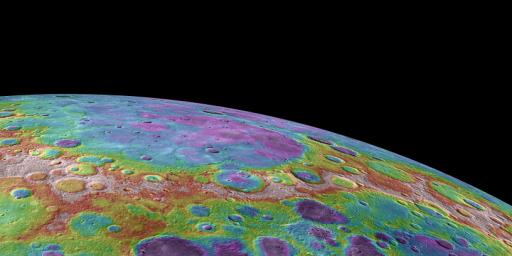Lowlands in Mercury’s North
Caption:
This image shows a perspective view, looking towards Mercury's north and colorized by the topographic height of the surface. The purple colors are the lowest and white is the highest. As shown in
this previous release
, the total dynamical range of the height variation measured on Mercury is roughly 10 km. The craters
Rubens and Monteverdi
, with diameters of 159 km and 134 km respectively, are located near the middle of this view. Mercury's
expansive northern plains
, extending off the upper limb of the planet in this image, have a lower height relative to the neighboring surface.
Instruments:
Mercury Laser Altimeter (MLA), Wide Angle Camera (WAC) of the Mercury Dual Imaging System (MDIS)
Center Longitude:
approximately 280° E
Background Info:
The MESSENGER spacecraft is the first ever to orbit the planet Mercury, and the spacecraft's
seven scientific instruments and radio science investigation
are unraveling the history and evolution of the Solar System's innermost planet. Visit the
Why Mercury?
section of this website to learn more about the key science questions that the MESSENGER mission is addressing. During the one-year primary mission, MDIS acquired 88,746 images and extensive other data sets. MESSENGER is now in a year-long extended mission, during which plans call for the acquisition of more than 80,000 additional images to support MESSENGER's science goals.
These images are from MESSENGER, a NASA Discovery mission to conduct the first orbital study of the innermost planet, Mercury. For information regarding the use of images, see the MESSENGER
image use policy
.
Cataloging Keywords:
| Name |
Value |
Additional Values |
| Target |
Mercury |
|
| System |
|
|
| Target Type |
Planet |
|
| Mission |
MESSENGER |
|
| Instrument Host |
MESSENGER |
|
| Host Type |
Orbiter |
|
| Instrument |
Mercury Dual Imaging System (MDIS) |
Mercury Laser Altimeter (MLA) |
| Detector |
Wide Angle Camera (WAC) |
|
| Extra Keywords |
Color, Crater, Radio |
| Acquisition Date |
|
| Release Date |
2012-08-23 |
| Date in Caption |
|
|
| Image Credit |
NASA/Johns Hopkins University Applied Physics Laboratory/Carnegie Institution of Washington |
| Source |
photojournal.jpl.nasa.gov/catalog/PIA16388 |
| Identifier |
PIA16388 |

 Planetary Data System
Planetary Data System
